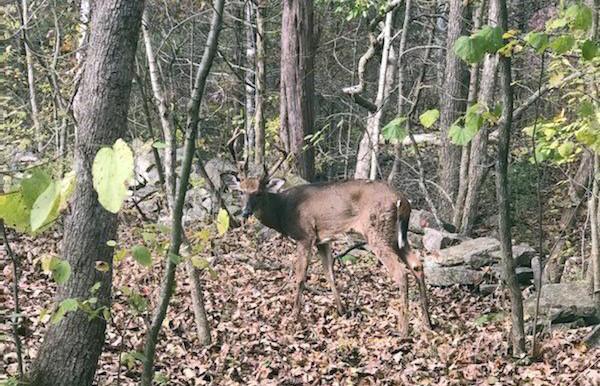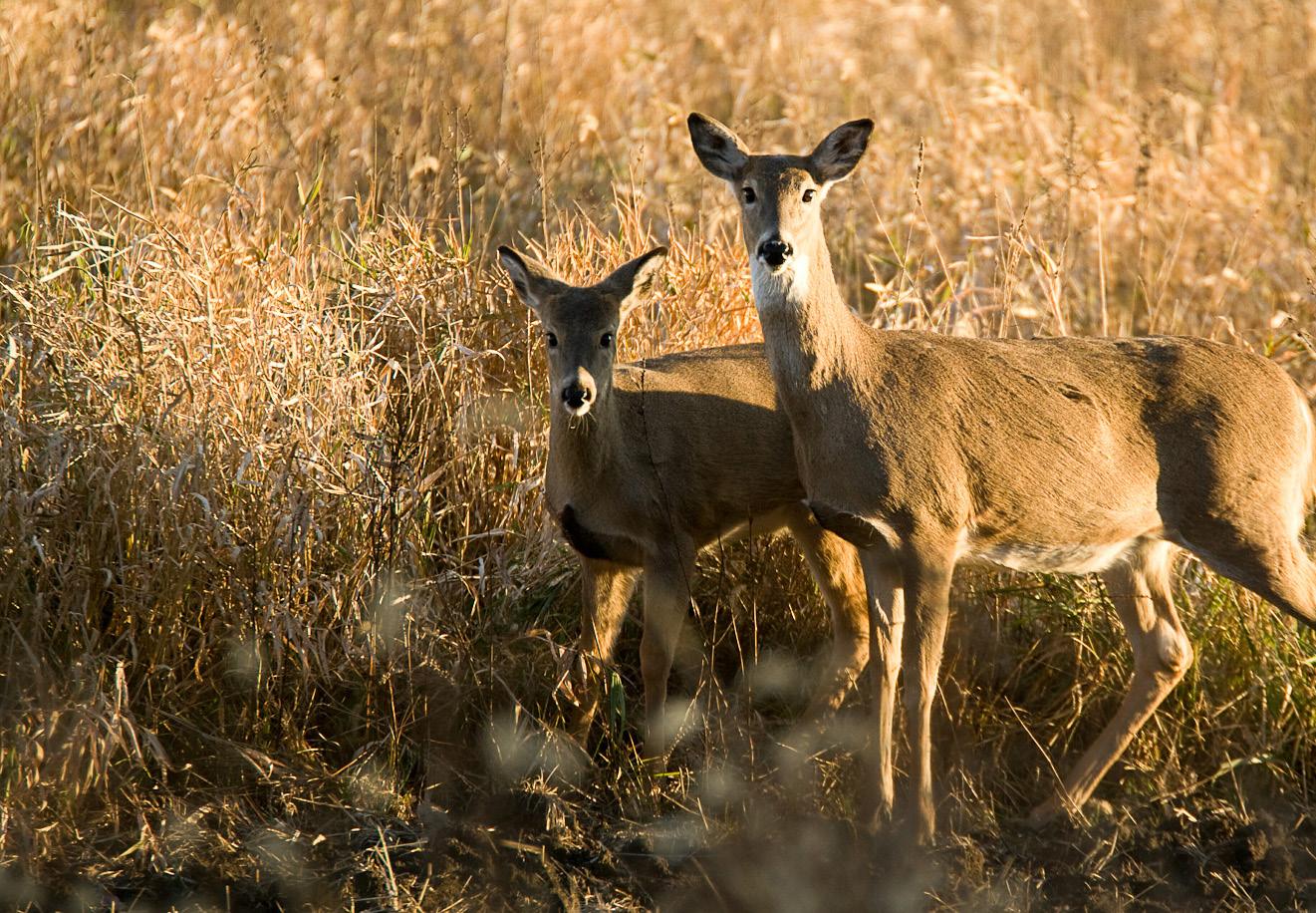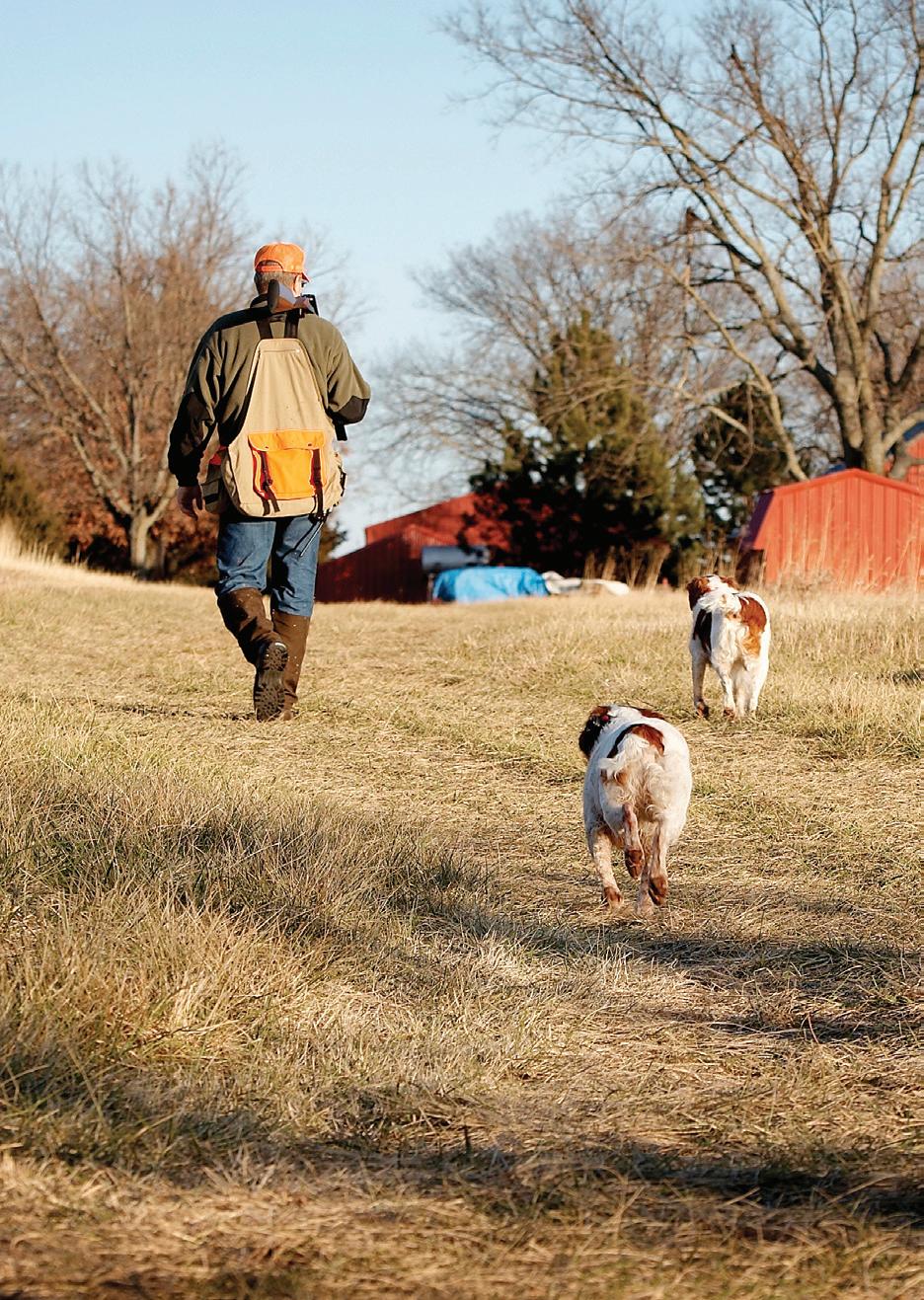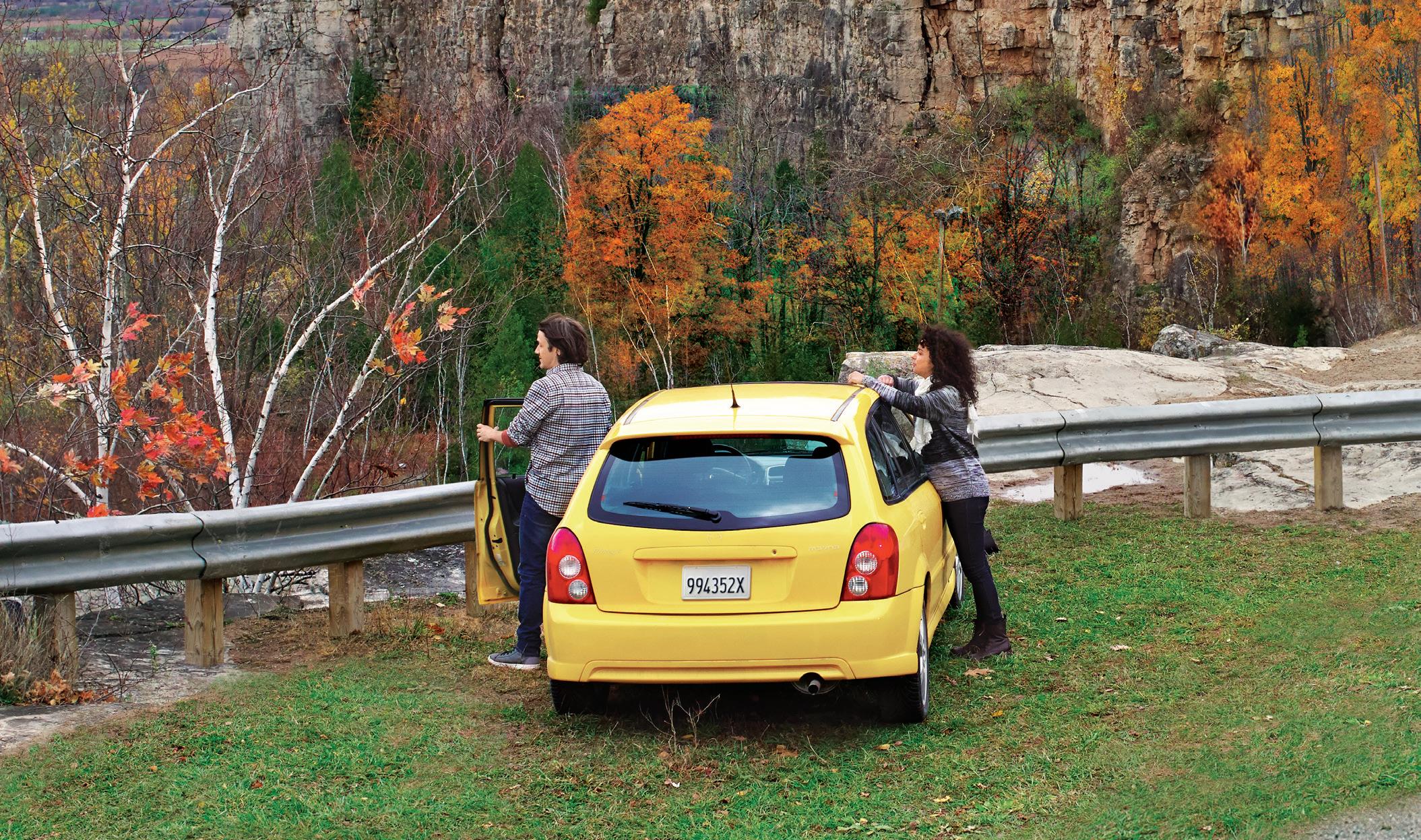
20 minute read
Fishing in Missouri's State Parks
Fishing in Missouri's Four Trout Parks
Montauk State Park M ontauk State Park, located southwest of Salem in Dent County, is a favorite of trout anglers. Known for its variety of trout fishing habitat and regulation zones, Montauk holds appeal for trout anglers regardless of their chosen style of fishing.
Montauk is divided into three fishing zones. Fly fishermen are fond of a zone set aside for them. The Fly Fishing only zone is strictly catch and release fishing. Flies with single hooks are allowed.
"The catch and release waters at Montauk are treasured by fly fishermen," said well-known fly fisherman Mark Van Patten. "Some of the largest fish in the park are found in this quarter-mile stretch of water."
There is also a 3-acre spring-fed pond to fish. Large, cruising rainbows tease anglers here. Although they do rise to insect hatches, most fish feed underwater on the plentiful supply of scuds and small suckers. Deepwater is available in the middle of the lake, but the greatest success is around the weedy cover around the edges. The lake is only open to fishing on the dam side. Signs mark legal fishing areas.
The flow through the dam creates a deep pool, which holds lots of fish. Past this point the stream flows several yards through a bog before joining the hatchery outflow stream. The thick weedy cover makes this stretch difficult to fish. Trout holding here are very spooky. Streamside brush makes fly casting difficult as well. Utilizing a shorter fly rod and roll casting are the proper techniques to fish the cover thoroughly.
The streamflow here enters the hatchery and resumes below the hatchery where it flows for a couple of hundred yards. The excellent habitat here ensures good fish populations. They are heavily pressured, and therefore, are most often very challenging to catch. A big draw to this section of stream is the fact that numerous brood fish in the three to five pound range can be seen here.
Montauk Spring Branch forms where the hatchery outflow and the flow from the dam collide. The spring branch flows for several hundred yards before dumping into Current River. This section is open to catch and keep fishing with no bait restrictions. The daily limit is four trout.
A series of small dams slow the flow and make this section relatively easy for anglers who like to fish the bottom with prepared baits, salmon eggs, plastic worms and jigs. This stretch is heavily fished during the regular season from March 1 through the end of October.
Another flow begins at Montauk Springs, the headwaters of Current River. The first section of stream flows over a mile before entering Montauk Spring Branch. This section is fly fishing only, but four trout may be kept here. This area is the most appealing to fly anglers, because of the natural riffles and pools. "This is classic trout water like you find in many areas out West," Van Patten said. "Dry fly fishing can be superb during hatches, but most fish will be caught on a variety of nymph patterns."
Nymph fishing is highly effective at Montauk. Most fish nymphs under indicators coupled with 4-to-7- feet of leader. Fluorocarbon leader in 4x to 6x is most commonly used. However, for finicky trout, 7x may be required. Popular nymph patterns include: Prince, Hare's Ear, Pheasant Tails, Scuds, Egg Patterns, San Juan Worms, in sizes #14-#18, and Wooly Buggers in #8 and #10.
Montauk State Park offers a wide variety of amenities, including a lodge, cabins, campground and restaurant. Check mostateparks.com/park/montaukstate-park for more information.
Bennett Spring State Park
Bennett Spring State Park is located 12 miles west of Lebanon on Highway 164. Bennett Spring is Missouri's third largest spring, with an average flow of 100,000,000 gallons of water each day. The spring branch offers a mile and a half of trout fishing in three separate zones.
Missouri's trout fishing tradition is said to have begun at Bennett Spring, the first trout park in the state. Today it is still the most popular trout park among anglers due to the world-class fishing found there.
Zone 1 is fly fishing only. A liberal definition of flies allows spin fishermen to throw single-hooked RoosterTails and jigs. Fly fishermen do well on a wide variety of patterns. This section is primarily catch and keep, with a four fish per day limit, but a small section does provide for catch and release fishing. Fifty fish days are not uncommon here.
Zone 2 allows all artificial lures and flies, with either single or treble hooks, as well as soft plastic baits. Marabou jigs, small spinners and plastic trout worms are favorites of spin fishermen. Fly fishermen find great success when using San Juan Worms, egg patterns, and wooly buggers.
Zone 3 is for folks who like to use natural baits, prepared baits, and soft plastics. Artificial flies and lures are not legal in this section. There is a good population of smallmouth bass in this section, too.
Most trout caught at Bennet Spring are stocker sized fish, but anglers should be aware that the occasional brown trout does swim up from the Niangua River's trophy brown trout area.
Many modern amenities are available for guests at Bennett Spring, including a lodge, cabins, campground, and a well-stocked store. Visit mostateparks.com/park/bennett-spring-state-park for more info.
Roaring River State Park
Located in the southwest Ozark hills, Roaring River sits in a steep narrow valley, blanketed with a rugged landscape. Roaring River emerges from the base of a shady limestone bluff and spews out an average of 20,000,000 gallons cold, clear water daily. Two and a half miles of spring branch is stocked daily with rainbow trout from March 1 until the end of October.
The spring branch is divided into three zones. No wading is allowed, except in the catch-and-release area in Zone 2.

Zone 1 has been structured with a series of shadow riffles and deep pools. Wading isn't allowed because of the pool depths. It is vital to get baits down deep here. The absence of wading anglers allows aquatic insects to maintain healthy populations, which are fed on voraciously by trout. Fish grow quickly in this environment. Matching the hatch can be productive. Check the park store for the most popular fly patterns.
Zone 2 has a catch and release areas where both waders and swimmers are allowed, so everyone must be on their best behavior. Fish tend to be larger in this zone.
Zone 3 is unique among the trout parks. There is little bank access and no landscaping, which means you may fish in a wilder setting with little competition from other anglers.

Bait fishermen do well drifting salmon eggs under a small indicator. Fly fishermen do well on pheasant tails and hares's ear nymphs, and occasionally dry flies. In-line spinners cast into pools and near root wads will coax trout from their hiding spots. The Emory Melton Inn and Conference Center is gorgeous. For information about other park amenities at Roaring River, check out: mostateparks.com/park/ roaring-river-state-park.
Maramec Spring Park
Missouri's fourth trout park, Maramec Spring Park, is owned and operated by the James Foundation. Maramec Spring, the fifth largest in the state, and puts 100,000,000 gallons of water per day into the half-mile long Maramec Spring Branch, before it enters the Meramec River. Yes, the two spellings are correct. The James Foundation maintains an agreement with the MDC to take care of trout rearing facilities and the fishing program within park boundaries. There are no fishing zones at the park. Spin fishing is most popular at Maramec Spring. Favorite artificial baits include RoosterTails and a locally made jig called the Kings jig. Prepared baits such as PowerBait and Lisa's Trout Bait are commonly used as well. Plastic trout worms are highly effective in the deeper pools.
Trout worms and baits fished on two-pound line and weighted to get the bait down deep account for many rainbows each season. Many anglers like to drift the baits under a float, keeping them a few inches off of the bottom.
Trout anglers do not have a lot of room to fish at Maramec Spring Park, yet they do well with a variety of flies and nymphs, including pheasant tails, hare's ear, San Juan Worms, blonde leeches, and midge patterns. Maramec Spring Park will be the site of an experimental program in 2020. Anglers will be allowed to keep five trout for five dollars. Anglers 15 and under will pay three dollars.
Prices will also increase for the three state parks for a four fish per day limit from three dollars to five dollars for adults and from two to three dollars for those 15 and younger.
Our four Missouri trout parks offer outstanding fishing opportunities amidst some of the most spectacular scenery in the Ozarks. Try all four this year and decide for yourself which is your favorite.
Bill Cooper
(Cover) Bennett Spring trout opener. (Photo: Courtesy of MDC)
(Left) Montauk State Park is a favorite of trout fishermen and offers three zones to accommodate any style of fishing. (Photo: Courtesy of Bill Cooper)
(Top) Commercial baits are popular among trout fishermen at all of the trout parks in Missouri. (Photo: Courtesy of Bill Cooper)
MISSOURI DEPARTMENT OF CONSERVATION
MDC Finds More CWD, Disease Still Rare in State
The Missouri Department of Conservation (MDC) reports that it has confirmed 24 new cases of chronic wasting disease (CWD) in Missouri from nearly 27,000 tissue samples collected from white-tailed deer and submitted for disease testing this season. Most of the tissue samples were taken from hunter-harvested deer.

The new cases were found in the following counties: 2 in Adair, 5 in Franklin, 5 in Linn, 2 in Macon, 2 in Perry, 5 in Ste. Genevieve, 2 in Stone, and 1 in Taney.
CWD is a deadly disease in white-tailed deer and other members of the deer family. The purpose of MDC’s CWD sampling and testing efforts is to find cases early so the Department can limit the spread of the disease. Learn more about CWD at mdc. mo.gov/cwd.
“While any new cases of CWD are not good news, we are happy that no cases have been found in new counties this year,” said MDC Wildlife Disease Coordinator Jasmine Batten. “Overall, CWD remains relatively rare in the state and even in most areas where it has been found. These results suggest that our disease-management actions are working.”
The 24 new cases bring the total number of CWD cases in the state to 140. MDC has tested about 130,000 deer since the first cases of CWD were found in free-ranging deer in Missouri in 2012. Get more information at mdc.mo.gov/cwd under “CWD in Missouri.”
Batten added that there were only three new CWD cases near the Missouri-Arkansas border, an area of heightened concern considering the extent of CWD in northwest Arkansas.
“More than 700 deer and elk in northwest Arkansas have been confirmed to have CWD in the past few years, so we consider finding only three new cases in Stone and Taney counties of southwest Missouri to be good news.”
This visibly ill deer, found in Ste. Genevieve County in October, tested positive for CWD. (Photo: Courtesy of MDC)
About 8,000 of the nearly 27,000 tissue samples MDC had tested this season were collected by taxidermists and meat processors around the state as part of the Department’s voluntary CWD sampling efforts. Free voluntary sampling continues through the end of deer season, Jan. 15. Get more information at mdc.mo.gov/cwd under “Voluntary CWD Sampling All Season.”
MDC’s mandatory sampling efforts in 29 counties during the opening weekend of the November portion of the firearms deer season yielded about 18,800 of the nearly 27,000 tissue samples tested for CWD.
MDC will continue its efforts to manage CWD after the Jan. 15 close of deer season into March. MDC staff will again work with landowners on a voluntary basis in the immediate areas around where recent cases of CWD have been found to remove more potentially infected deer. The goal of the effort is to limit the spread of the disease and to keep the percentage of deer that have the disease low. Learn more at mdc.mo.gov/cwd under “Post Season Targeted Culling.”
Learn more about CWD and MDC’s efforts to limit its spread at mdc.mo.gov/cwd.
MDC Reports Final Deer Harvest
Missouri's 2019-2020 deer-hunting season ended Jan. 15 with the Missouri Department of Conservation (MDC) reporting a preliminary total deer harvest of 285,483. Of the deer harvested, 133,914 were antlered bucks, 27,931 were button bucks, and 123,638 were does.
Top harvest counties for the overall deer season were Franklin with 6,247 deer checked, Callaway with 5,703, and Texas with 5,157.
Hunters harvested 290,224 deer during the 2018-2019 overall deer hunting season with 136,851 being antlered bucks, 30,113 being button bucks, and 123,260 being does.
Archery Deer Results
Deer hunting ended with the close of the archery season. Preliminary data from MDC showed that hunters checked 61,209 deer during the 2019-2020 archery deer season. Top counties for the archery deer season were Jefferson with 1,604 deer checked, Franklin with 1,294, and St. Louis with 1,227.
Hunters checked 52,923 deer during the 2018-2019 archery deer season.
While the total deer harvest was down slightly from the year before, the archery deer harvest was considerably higher this year. According to MDC Cervid Program Supervisor Jason Isabelle, season timing was a factor.

“The shift in the calendar this year with Thanksgiving occurring later in November resulted in archers having an extra week of prime hunting before the November portion of firearms season started,” Isabelle explained. “These extra days of hunting during the rut when bucks are particularly vulnerable to harvest, and an increasing trend in the number of archery hunters, contributed to a record year of archery deer harvest.”
Isabelle added that the calendar shift caused the November portion of firearms season to occur a week later than last year and during peak breeding when buck movement is reduced.
“As we get closer to the middle of November, bucks simply don’t have to move as much in search of receptive does as they do earlier in the month, making them less vulnerable to harvest,” Isabelle explained. “Whenever this shift in season timing occurs, we expect a decline in harvest during the November portion of firearms season, which is when most of each year’s harvest occurs.”
For more information on this season’s deer harvest totals, visit the MDC website at extra.mdc.mo.gov/widgets/ harvest_table/.
For more information on deer harvests from past years, visit huntfish.mdc.mo.gov/hunting-trapping/species/deer/ deer-harvest-reports/deer-harvest-summaries.
For more information on deer hunting in Missouri, visit huntfish.mdc.mo.gov/hunting-trapping/species/deer.
Archery Turkey Results
Fall archery turkey hunting also ended Jan. 15. Preliminary data from MDC showed 2,406 turkeys harvested. Top counties for the fall archery turkey season were Callaway with 69 birds checked, Greene with 63, and Franklin with 62.
Hunters harvested 2,055 turkeys during the 2018 fall archery turkey season.
A white-tailed deer doe and fawn. (Photo: Noppadol Paothong)
MISSOURI DEPARTMENT OF CONSERVATION
Test Your Fishing Skills Through MDC's First Blue-Ribbon Trout Slam
The Missouri Department of Conservation (MDC) and Trout Unlimited encourage anglers to test their fishing skills and pursue a “Blue-Ribbon Trout Slam” from Missouri’s nine blue-ribbon trout streams.
“Missouri’s blue-ribbon trout streams are areas in the state where trout reproduce naturally,” explained MDC Fisheries Programs Specialist Andrew Branson. “The fish are wary of predators, which makes for an authentic and challenging experience for anglers.”
Where to fish
The Blue-Ribbon Trout Slam honors anglers who catch a trout in at least 5 of MDC’s 9 blue-ribbon trout streams:
• Barren Fork Creek in Shannon County • Blue Springs Creek in Crawford County • Crane Creek in Lawrence County • Current River in Dent County • Eleven Point River in Oregon County • Little Piney Creek in Phelps County • Mill Creek in Phelps County • North Fork of the White River in Ozark County • Spring Creek in Phelps County
How to enter
The Blue-Ribbon Trout Slam is divided into three levels: • Bronze: Catch a trout from 5 of the 9 blue-ribbon trout areas and receive a certificate and bronze pin. • Silver: Catch a trout from 7 of the 9 blue-ribbon trout areas and receive a certificate and silver pin. • Gold: Catch a trout from all 9 blue-ribbon trout areas and received a certificate, gold pin, and medallion.
All pins and medallions awarded to participants have been provided by Trout Unlimited.

Anglers need to possess a trout permit if they want to keep their trout. Trout of any size will qualify for the Blue-Ribbon Trout Slam, but trout under 18 inches must be released.
Anglers can complete a Blue-Ribbon Trout Slam entry form each time they catch a trout. They may also submit a picture of their trout if they wish, but it is not required.
Once participants accomplish one of the three TroutSlam levels, MDC will verify their submissions and mail them their award. Additionally, anglers can have their successes listed on the MDC website.
“This Trout Slam is a great new program that will encourage anglers to get outside and discover nature throughout the year,” said Branson.
For more information on the Blue-Ribbon Trout Slam, visit mdc.mo.gov/troutslam.
To learn more about Missouri’s trout fishing areas, go to short.mdc.mo.gov/ZmT.
MISSOURI STATE PARKS
Department of Natural Resources and Ameren Missouri’s Missouri Central Railroad sign agreement on Rock Island Line Corridor
The Missouri Department of Natural Resources signed an Interim Trail Use Agreement with Missouri Central Railroad Company, a wholly owned subsidiary of Ameren Missouri, paving the way for the future railbanking of 144 miles of the former Chicago, Rock Island and Pacific Railroad corridor, which stretches from Windsor to Beaufort, Missouri. The Interim Trail Use Agreement ensures the preservation of the former railroad corridor for future transportation use and facilitates the eventual donation of the property to the department for recreational trail use.
“Successfully negotiating an Interim Trail Use Agreement was a crucial first objective in this process, and I’m glad we finally reached it,” said Dru Buntin, deputy director of the Department of Natural Resources. “It’s important to remember that this was just the first step on what promises to be a long journey. We can all envision a world-class trail while acknowledging there will be some challenges between here and there.”
“[This] trail agreement marks a significant milestone in Ameren Missouri’s efforts to donate the remaining 144 miles of the scenic Rock Island Corridor to the state for possible use as a recreational trail,” said Mark Birk, senior vice president of customer and power operations for Ameren Missouri. “Over the last several years, we have been preparing the land for future use by clearing vegetation and removing steel and railroad ties. We will continue to work toward the vision of this trail one day becoming a world-class biking destination that will benefit the communities along the trail.”
Signing the agreement does not imply that a fully developed trail is certain. The agreement requires approximately $9.8 million be raised before the property will be transferred to the department to help cover initial development, security and management costs. For now, the corridor remains
Drew Buntin, deputy director of the Missouri Department of Natural Resources, and Mark Birk, senior vice president of customer and power operations for Ameren Missouri, sign the agreement on the Rock Island Line Corridor. (Photo: Courtesy of Missouri State Parks)

Missouri Central Railroad’s property and is not open for public use. An estimated total of $65 million to $85 million will ultimately be needed to fully develop the trail. Leading the fundraising effort will be the Missouri State Parks Foundation, a nonprofit organization established to support Missouri’s state park system. The project’s funding will likely require a combination of private, public and corporate sources. Interested donors should contact the Missouri State Parks Foundation to learn more about partnering in this effort.
“We are looking forward to working closely with the Missouri State Parks Foundation on this project,” said Mike Sutherland, interim division director of Missouri State Parks. “The scope of this project is massive, but the foundation is uniquely positioned to bring together a wide array of supporters into a diverse partnership that is unified behind a single goal.”
If adequate funding can be raised, the proposed trail will have to be developed in sections, each of which will present its own construction challenges.
More information about the Rock Island Line Corridor is available at https://mostateparks.com.
Healthy is NATURE



Get healthy in nature this year. mdc.mo.gov/places–go














MISSOURI-BORN. MISSOURI-BASED. DIAMOND PET FOODS PROUDLY SUPPORTS ALL THOSE WHO HELP KEEP OUR STATE BEAUTIFUL.




©2016 SCHELL & KAMPETER, INC. DIAMOND, DIAMOND & DESIGN, DIAMOND NATURALS, TASTE OF THE WILD AND APPALACHIAN VALLEY

ARE REGISTERED TRADEMARKS AND DIAMOND CARE AND THE TASTE OF THE WILD SEAL ARE TRADEMARKS OF SCHELL & KAMPETER, INC.
Small farm, big memories.
Recreational Land Loans It’s true, memories can be made anywhere. But those shared with family and friends on your own piece of rural land compare with little else. For more than 100 years, we have helped people finance their dream properties from a handful of acres to thousands. Our passion for rural Missouri drives us but our experience and knowledge of rural financing sets us apart from other lenders.

a Small to large acreage financing a Competitive interest rates to save you money a Fixed rates a Service from online to on-the-farm with experienced staff a Cabins, pole barns, outbuildings and other site improvements can be included in your financing
WWW.MYFCSFINANCIAL.COM 1.800.407.8984 Find an FCS Financial office near you:
Growing Relationships. Creating Opportunities. is a trademark of FCS Financial, ACA.
Road trip. We didn’t choose the perfect playlist. Or program the GPS. But we did fuel the car that made you realize there are no wrong turns, only new adventures. When the energy you invest in life meets the energy we fuel it with, amazing journeys happen.










